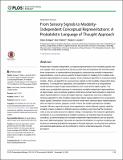From Sensory Signals to Modality-Independent Conceptual Representations: A Probabilistic Language of Thought Approach
Author(s)
Erdogan, Goker; Yildirim, Ilker; Jacobs, Robert A.
DownloadErdogan-2015-From Sensory Signals.pdf (1.700Mb)
OPEN_ACCESS_POLICY
Open Access Policy
Creative Commons Attribution-Noncommercial-Share Alike
Terms of use
Metadata
Show full item recordAbstract
People learn modality-independent, conceptual representations from modality-specific sensory signals. Here, we hypothesize that any system that accomplishes this feat will include three components: a representational language for characterizing modality-independent representations, a set of sensory-specific forward models for mapping from modality-independent representations to sensory signals, and an inference algorithm for inverting forward models—that is, an algorithm for using sensory signals to infer modality-independent representations. To evaluate this hypothesis, we instantiate it in the form of a computational model that learns object shape representations from visual and/or haptic signals. The model uses a probabilistic grammar to characterize modality-independent representations of object shape, uses a computer graphics toolkit and a human hand simulator to map from object representations to visual and haptic features, respectively, and uses a Bayesian inference algorithm to infer modality-independent object representations from visual and/or haptic signals. Simulation results show that the model infers identical object representations when an object is viewed, grasped, or both. That is, the model’s percepts are modality invariant. We also report the results of an experiment in which different subjects rated the similarity of pairs of objects in different sensory conditions, and show that the model provides a very accurate account of subjects’ ratings. Conceptually, this research significantly contributes to our understanding of modality invariance, an important type of perceptual constancy, by demonstrating how modality-independent representations can be acquired and used. Methodologically, it provides an important contribution to cognitive modeling, particularly an emerging probabilistic language-of-thought approach, by showing how symbolic and statistical approaches can be combined in order to understand aspects of human perception.
Date issued
2015-11Department
Massachusetts Institute of Technology. Department of Brain and Cognitive SciencesJournal
PLOS Computational Biology
Publisher
Public Library of Science
Citation
Erdogan, Goker, Ilker Yildirim, and Robert A. Jacobs. “From Sensory Signals to Modality-Independent Conceptual Representations: A Probabilistic Language of Thought Approach.” Edited by Paul Schrater. PLoS Comput Biol 11, no. 11 (November 10, 2015): e1004610.
Version: Final published version
ISSN
1553-7358
1553-734X